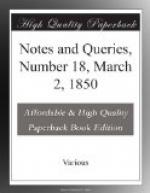I beg to state that I have impressions of two large prints, one of the “House,” and the other of the “Sign.” They were published in 1740.—“Joshua Kirby,” del., “John Fossey,” sculpt.
I have also a smaller print of the “Sign” taken from the opposite side—from the larger one—apparently by the same parties, but the names of the drawer and engraver are cut off.
I think the Sign was not take down till after 1795, as I have a recollection of having passed under it when a boy, in going from Norwich to Ipswich.
The sign was large and handsome, and extended across the road.
In Kirby’s Print, it is stated to have cost Mr. James Peck, who was a merchant at Norwich, 1057l.
The prints are not very scarce, and may be got at many of the printsellers in London.
J.B.
About twenty years ago I have seen hanging up on the wall of the principal entry of this inn, a print of its original front, comprising the various figure, coats of arms, &c. which adorned it: in this account the founder Peck was called a citizen of Norwich, and the traveller was puzzled by this piece of information. “It is called Scole Inn, because it is at about the same distance from Norwich, Ipswich, and Bury.”
M. Prendergast.
7. Serjeant’s Inn. Fleet Street, Feb. 19. 1850.
Killigrew Family and Scole Inn Sign (No. 15. p. 231.).—Doubtless there are pedigrees of the Killigrew family in the Visitations of Cornwall, which would answer Mr. Lower’s questions. Many notices of them also occur in Gilbert’s History of Cornwall, and Wood’s Athenae Oxon., Bliss. ed., and both those works have good indexes.
There is a folded engraving of Scole Inn Sign (No. 16. p. 245.) in Armstrong’s History of Norfolk, vol. ii. p. 144., but I never could learn when or why the sign was removed. The couchant stag in the centre was the Cornwallis crest.
Braybrooke.
Audley End.
Pavoise of the Black Prince (No. 12. p. 183).—It is very probably that the Pavoise which “Bolton” mentions as hanging in his time at the tomb of Edward the Black Prince, was no part of the original collection.
“A quilted coat-armour, with half-sleeves tabard fashion,” reads oddly as part of this prince’s costume; but we know that sometimes “Coming events cast their shadows before.”
T.W.
Welsh Ambassador.—The following use of the word “Welsh” in metaphor, may perhaps serve as a clue to, or illustration of, G.’s query (No. 15. p. 230.):
Andrew. “In
tough Welsh parsley, which in our vulgar tongue,
is Strong hempen altars.”—Beaumont
and Fletcher, Elder
Brother, Act. 1. ad fin.
Petit Andre
Pleissis-les-Tours, Fevrier, 1850.




